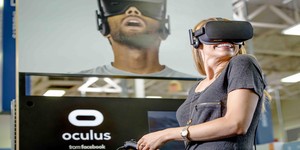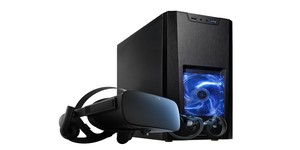Oculus VR outs focal surface display technology
May 16, 2017 | 10:56
Companies: #facebook #oculus #oculus-rift #oculus-vr #research

Facebook-owned Oculus VR's research arm has published a paper on focal surface displays, a technology which the company claims could dramatically boost the visual clarity and depth of focus available from future virtual reality hardware.
Founded in 2012 by since-ousted Palmer Luckey and launched to fame following a record-breaking crowdfunding campaign for developer-centric virtual reality headsets, Oculus VR hit the big time when the company was acquired by Facebook in a deal valued at $2.3 billion in cash and shares. Since then, the company has been more or less silent on the next generation of virtual reality hardware, understandably wishing to concentrate more on the success of its commercialised Oculus Rift headset against stiff competition from HTC's Vive and Sony's PlayStation VR.
This week, though, the company lifted the veil just a little with a look at something further ahead than usual: focal surface display technology, which the company claims could help future virtual reality headsets improve visual clarity and depth of focus.
The technology works, the company explains in a blog post on the subject, by using spatial light modulators (SLMs) which 'bend' the focus of the headset around 3D objects, simulating how the human eye focuses on objects at varying depths. The result, the company claims, is improved image sharpness and a more natural feel to the rendered scene.
Development of the technology wasn't entirely smooth, however. 'Quite frankly, one of the reasons this project ran as long as it did is that we did a bunch of things wrong the first time around,' 'Oculus research scientist Alexander Fix joked following his team's publication. 'Manipulating focus isn’t quite the same as modulating intensity or other more usual tasks in computational displays, and it took us a while to get to the correct mathematical formulation that finally brought everything together. Our overall motivation was to do things the ‘right’ way—solid engineering combined with the math and algorithms to back it up. We weren’t going to be happy with something that only worked on paper or a hacked together prototype that didn’t have any rigorous explanation of why it worked.'
Sadly, Oculus currently has no timescale for commercialisation of the display technology, though its paper (PDF warning) is readily accessible and will be presented at the SIGGRAPH graphics conference in July. The company has also published an explanatory video.
Founded in 2012 by since-ousted Palmer Luckey and launched to fame following a record-breaking crowdfunding campaign for developer-centric virtual reality headsets, Oculus VR hit the big time when the company was acquired by Facebook in a deal valued at $2.3 billion in cash and shares. Since then, the company has been more or less silent on the next generation of virtual reality hardware, understandably wishing to concentrate more on the success of its commercialised Oculus Rift headset against stiff competition from HTC's Vive and Sony's PlayStation VR.
This week, though, the company lifted the veil just a little with a look at something further ahead than usual: focal surface display technology, which the company claims could help future virtual reality headsets improve visual clarity and depth of focus.
The technology works, the company explains in a blog post on the subject, by using spatial light modulators (SLMs) which 'bend' the focus of the headset around 3D objects, simulating how the human eye focuses on objects at varying depths. The result, the company claims, is improved image sharpness and a more natural feel to the rendered scene.
Development of the technology wasn't entirely smooth, however. 'Quite frankly, one of the reasons this project ran as long as it did is that we did a bunch of things wrong the first time around,' 'Oculus research scientist Alexander Fix joked following his team's publication. 'Manipulating focus isn’t quite the same as modulating intensity or other more usual tasks in computational displays, and it took us a while to get to the correct mathematical formulation that finally brought everything together. Our overall motivation was to do things the ‘right’ way—solid engineering combined with the math and algorithms to back it up. We weren’t going to be happy with something that only worked on paper or a hacked together prototype that didn’t have any rigorous explanation of why it worked.'
Sadly, Oculus currently has no timescale for commercialisation of the display technology, though its paper (PDF warning) is readily accessible and will be presented at the SIGGRAPH graphics conference in July. The company has also published an explanatory video.

MSI MPG Velox 100R Chassis Review
October 14 2021 | 15:04








Want to comment? Please log in.